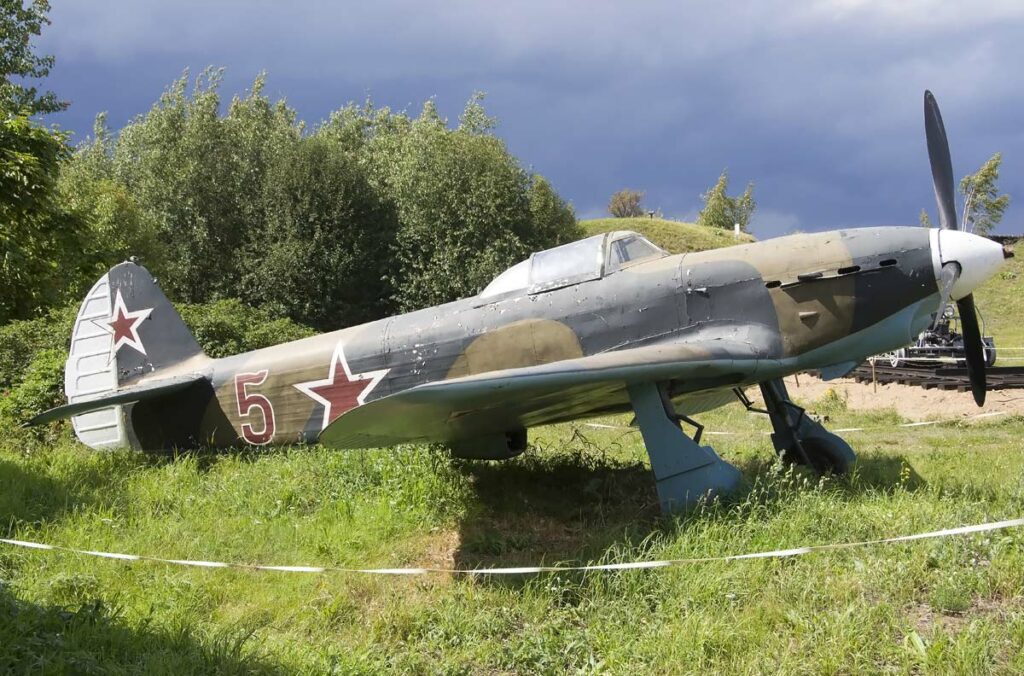The Yakovlev Yak-1, a key WWII Soviet fighter, featured a Klimov M-105 engine, known for agility, robust design, and significant impact on the Eastern Front.
This article examines the Yakovlev Yak-1, a crucial Soviet fighter aircraft of World War II. It explores the Yak-1’s development, design, performance, and military use, highlighting its role in combating German airpower on the Eastern Front and its significance in the Soviet air force during the critical early years of the war.
The Yakovlev Yak-1 was a fundamental Soviet fighter aircraft during World War II. Known for its agility and effectiveness, the Yak-1 played a critical role on the Eastern Front. This article aims to provide a detailed account of the Yak-1’s development, design, performance, and combat history, underscoring its importance in the Soviet Union’s air warfare strategy.
History of the Development of the Yakovlev Yak-1
In the late 1930s, as global tensions escalated, the Soviet Union recognized the need for modern, effective fighter aircraft to counter potential threats. The Yak-1’s development was initiated in response to this need, with the objective of creating a high-performance fighter that could match or exceed the capabilities of contemporary enemy aircraft.
The development program, led by the aircraft designer Alexander Yakovlev, began in earnest. The Yak-1 represented a significant departure from previous Soviet fighters, focusing on improved performance, speed, and agility. Its first flight occurred on January 13, 1940, marking a new era in Soviet fighter aviation.
The aircraft’s development was a crucial element in the Soviet Union’s efforts to bolster its air defense capabilities at the dawn of World War II.
Design of the Yakovlev Yak-1
The Yak-1’s design was a blend of innovation and practicality. It was powered by a Klimov M-105P V-12 liquid-cooled engine, capable of producing 1,100 horsepower (820 kW). The aircraft featured a mixed construction of wood and metal, which was both a strategic choice due to resource limitations and a design decision to optimize weight and durability.
Measuring 8.5 meters in length with a wingspan of 10 meters, the Yak-1 was compact yet robust. Its design emphasized good visibility for the pilot, a critical factor in dogfights. The Yak-1 was also one of the first Soviet fighters to incorporate a retractable landing gear and a closed cockpit, which improved aerodynamics and pilot protection.
One design drawback was its limited range, but this was deemed acceptable given its primary role as a short-range fighter. The Yak-1’s design continually evolved, with improvements made to enhance its performance and survivability throughout the war.

Performance of the Yakovlev Yak-1
In performance terms, the Yak-1 was a formidable aircraft. It could reach a top speed of approximately 600 kilometers per hour (373 miles per hour) and had a service ceiling of around 10,000 meters (32,800 feet). The aircraft’s operational range was about 700 kilometers (435 miles), sufficient for the short-range missions it was designed for.
Compared to contemporaries like the German Messerschmitt Bf 109 and the Focke-Wulf Fw 190, the Yak-1 was competitive, particularly in terms of maneuverability and climb rate. Its performance was a key factor in its success in air battles on the Eastern Front.
Military Use and Combat of the Yakovlev Yak-1
The Yak-1 was armed with a combination of machine guns and cannons, providing it with effective firepower against both air and ground targets. It saw extensive combat on the Eastern Front, participating in key battles and proving to be a worthy adversary against German aircraft.
The Yak-1’s impact in combat was significant, contributing to the Soviet air force’s ability to gain and maintain air superiority in various phases of the war. The aircraft was primarily used by the Soviet Union, with some limited use by allied nations.
The Yak-1 was eventually replaced by more advanced Soviet fighters, such as the Yak-3 and Yak-9, but its contribution to the Soviet war effort and its role in shaping aerial combat on the Eastern Front remain undeniable.
The Yakovlev Yak-1 stands out as a pivotal aircraft in World War II aviation history. Its development, design, and operational use significantly influenced the course of the air war on the Eastern Front. The Yak-1’s agility, robustness, and effective combat performance not only made it a respected fighter of its time but also a symbol of Soviet aeronautical engineering during a critical period of global conflict.
Back to the Warbirds section.